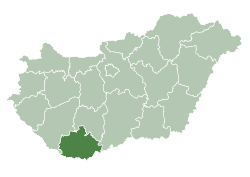Ibafa
| Ibafa | |
|---|---|
 Ibafa Location of Ibafa | |
| Coordinates: 46°09′18″N 17°54′59″E / 46.15489°N 17.91649°ECoordinates: 46°09′18″N 17°54′59″E / 46.15489°N 17.91649°E | |
| Country |
|
| County | Baranya |
| Area | |
| • Total | 29.30 km2 (11.31 sq mi) |
| Population (2001) | |
| • Total | 250 |
| • Density | 8.53/km2 (22.1/sq mi) |
| Time zone | CET (UTC+1) |
| • Summer (DST) | CEST (UTC+2) |
| Postal code | 7935 |
| Area code(s) | 73 |
Ibafa (Croatian: Ibaba) is a small village with a population of 250 in Baranya county, Hungary. The village hides in the valleys of Zselic, and it is an ordinary, non-intriguing place – but it is known all over in Hungary. The mayor is László Benes.
Ibafa became known in the 20th century, because the local priest liked pipes. He was a strange ecclesiastical person, always seen with a pipe in his mouth, playing cards with pals in the pub. A journalist stumbled on him, and wrote a tongue-twister verse beginning with the line:
- "Az ibafai papnak fapipája van, ezért az ibafai papi pipa papi fapipa"
meaning
- "The priest of Ibafa has a wooden pipe, so the priestly pipe of Ibafa is a priestly wooden pipe".[1]

In spite of being the most known village of Zselic, Ibafa is in trouble nowadays. The school and the parish church are closed (furthermore, the school building collapsed), many of the inhabitants are unemployed, there's no kindergarten, and the road is in a terrible condition. It is clear that the youth will move away if things do not change.
Anyway, there's hope to construct a new road to make Ibafa accessible from two directions.
Sights
There is a Pipe Museum in the village, where you can find the pipe of Ferenc Deák and Mihály Károlyi. It is an outstanding collection of the world's pipes.
The region of the village is simply a must see in Hungary for the fanciers of nature. The mixed forest, the untouched wildlife, the gently sloping hills and the fresh waters of the brooks are charming.
Gyűrűfű is a bio-village located close to Ibafa. There people try to live in harmony with nature, keeping the goods of civilization and peace of the Zselic together.
